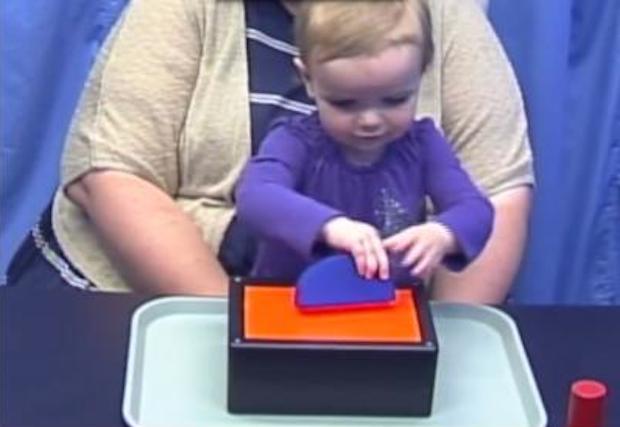Toddlers Know More Math Than You Think

Children frequently learn by observing people around them. Without any instruction, for example, many toddlers figure out how to turn on a TV or twist open a door handle. Now, scientists have found that 2- year-olds may also rely on probability to make sense of their world.
During a game of probability, many toddlers were able to choose a winning strategy, they found. In the game, the toddlers watched an adult play with one of two blocks to get a prize. When the toddlers played the game, they tended to choose the block that resulted in more prizes.
"In the real world, there are multitudes of possible ways to solve a problem, but how do we learn how to find the best solution?" lead author Anna Waismeyer, a postdoctoral researcher at the University of Washington's Institute for Learning and Brain Sciences in Seattle, said in a statement. "In our study, we wanted to see if young children could detect the difference between two imperfect ways of winning a game, and then use the better strategy to their own advantage." [That's Incredible! 9 Amazing Baby Abilities]
During the game, a child watched as a researcher placed a wooden block on a box that triggered a marble to roll out of a nearby machine, producing a noise that entertained the children, the researchers said. One block triggered the marble two-thirds of the time, and a second block of a different color and shape triggered it just one-third of the time.
The children watched the researchers play with the blocks for about 20 minutes. Afterwards, during free play, 23 of the 32 toddlers, or 72 percent, keenly picked the block that triggered the marble two-thirds of the time.
Perhaps the toddlers were choosing the winning block because of frequency, meaning they saw the marble more times with the winning block, and not because it had a higher rate overall of producing a winning result, the researchers said.
To find out, the researchers conducted the experiment again with a new group of toddlers. This time, both blocks triggered the marble machine four times, meaning they each had the same frequency. Yet the blocks kept the same probability: one activated the machine two-thirds of the time, and the other block triggered it only one-third of the time.
Get the world’s most fascinating discoveries delivered straight to your inbox.
When given the chance, 22 of the 32 toddlers, or 69 percent, chose the most successful block, suggesting they factored probability into their decision-making process.
"Our findings help explain how young children learn so quickly, even in an uncertain and imperfect world," said study co-author Andrew Meltzoff, the co-director of the Institute for Learning and Brain Sciences at the University of Washington. "Remarkably, they learn about causality even if the people they are watching make mistakes and are right some but not all of the time."
The study also shows that toddlers can observe and learn from other people doing an activity, experts added. Educators may capitalize on these findings to help children learn about other mathematical and cause-and-effect concepts through observation, the researchers noted.
"The current way of teaching probabilities relies on fractions and decimals, and many children struggle to understand these concepts when they are introduced in grade school," Waismeyer said. "Maybe it would be easier if we introduced these mathematical principles earlier and had our teaching mesh with or build on the intuitive ways that children think."
The study was published online July 16 in the journal Developmental Science.
Follow Laura Geggel on Twitter @LauraGeggel and Google+. Follow Live Science @livescience, Facebook & Google+. Original article on Live Science.

Laura is the managing editor at Live Science. She also runs the archaeology section and the Life's Little Mysteries series. Her work has appeared in The New York Times, Scholastic, Popular Science and Spectrum, a site on autism research. She has won multiple awards from the Society of Professional Journalists and the Washington Newspaper Publishers Association for her reporting at a weekly newspaper near Seattle. Laura holds a bachelor's degree in English literature and psychology from Washington University in St. Louis and a master's degree in science writing from NYU.


